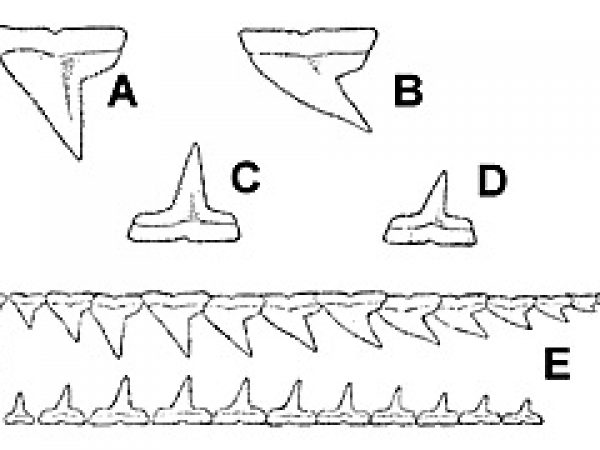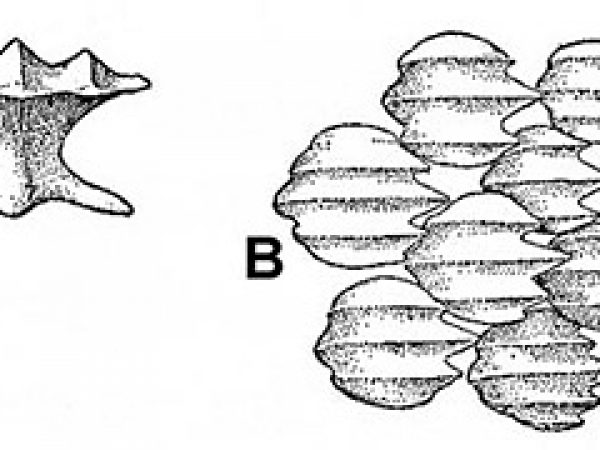Blacknose Shark
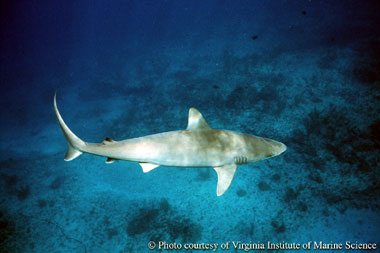
Carcharhinus acronotus
Blacknose sharks get their name from the dark blotch on the tip of their snout which often fades on older adults. This shark has a streamlined shape and matures to just over 4 feet long. It feeds on smaller fish and sometimes octopus, and falls prey to larger sharks. When confronted in the wild, the blacknose shark might take a defensive posture, but it is not linked to known shark attacks.
Order – Carcharhiniformes
Family – Carcharhinidae
Genus – Carcharhinus
Species – acronotus
Common Names
- English: blacknose shark
- Dutch: zwartsnuithaai
- French: requin nez noir
- Japanese: hanagurozame
- Portuguese: cação
- Spanish: cazon amarillo, lombo-preto, sarda, tiburon amarillo
Importance to Humans
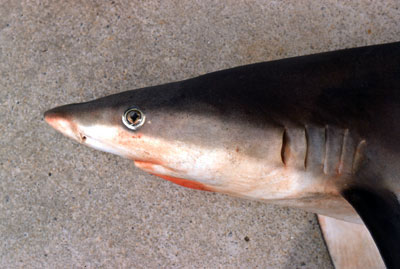
Viewed as too small to be of interest to fisheries in the United States. In Mexico, this species is locally consumed in the Campeche area to create a regional dish known as pan de cazón. The blacknose shark is also somewhat targeted for sport fishing as it is still able to be fished when the season for larger sharks is closed (Castro, 1983).
Danger to Humans
This shark poses little threat to humans and has never been reported in a shark attack case. However, when confronted by divers, the blacknose shark has been reported to give a threat display in the form of a hunched back with head raised and caudal lowered (Compagno, 2005).
Conservation
The highest cause of mortality stems from bycatch in the shrimp trawl and fisheries in the U.S., allowing overfishing. Population trends off the shores of countries like Brazil, U.S., and the Caribbean show a decline even though fisheries still catch large adults (Charlier, 2001). The observed decline places the Blacknose shark in the Near-Threatened category and it should be watched for further decline.
Fishing of this species is managed in the US by the National Marine Fisheries Service: Federal Fisheries Management Plan for Atlantic Tuna, Swordfish, and Sharks.
> Check the status of the blacknoase shark at the IUCN website.
The IUCN is a global union of states, governmental agencies, and non-governmental organizations in a partnership that assesses the conservation status of species.
Geographical Distribution
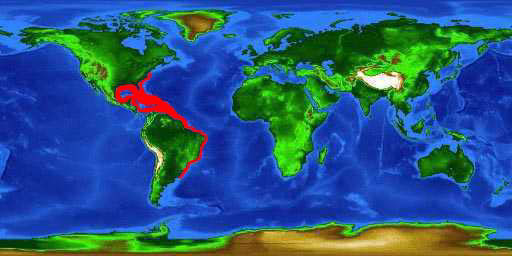
The distribution is limited to the western Atlantic Ocean from North Carolina (USA) south to southern Brazil, including the Caribbean Sea, Bahamas, and Gulf of Mexico (Compagno, 2005).
Habitat
This shark is found in coastal tropical and warm temperate waters of the western Atlantic Ocean. As an inshore species, the blacknose shark resides in waters of continental shelves over sandy and coral bottoms. There is segregation by size and sex in this species. Juveniles are typically found in shallow water while adults are located at greater depths (18-64 m (59- 210 feet)) (Compagno 2005).
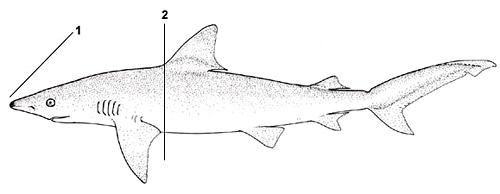
Distinguishing Characteristics
1. Snout with dusky blotch at tip – distinct and dark in juveniles, diffuse and dusky in adults
2. First dorsal fin originates over or behind the free tips of the pectoral fins
Biology
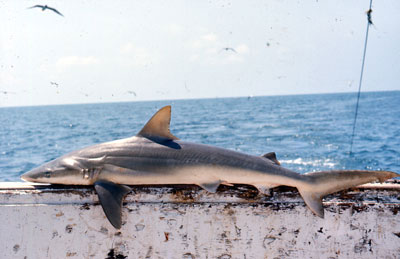
Distinctive Features
Their body is relatively small and slender with a somewhat long rounded snout and large eyes. This shark gets its common name from the characteristic black or dusky spot under the tip of the snout. The origin of the first dorsal fin is located over the free margins of the pectoral fins; the origin of the second dorsal fin is over or slightly anterior of anal fin origin. The margin of the anal fin is deeply notched. The interdorsal ridge (ridge between dorsal fins) is absent in this species and the caudal peduncle lacks a keel (Compagno, 2005).
Coloration
The blacknose shark is pale greenish or yellowish-grey with black or dusky tips on the second dorsal fin and dorsal caudal lobe. There is a black or dusky spot under the tip of the snout which is more distinct in younger individuals, hence the common name “blacknose shark” (Castro, 1983).
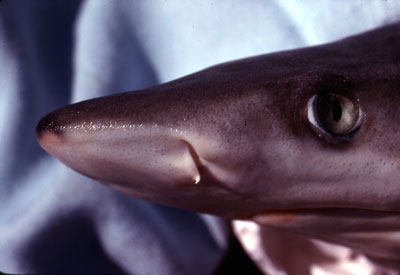
Dentition
The upper jaw of the blacknose shark has 12-13 rows of teeth on each side with 11-12 rows on the lower jaw. Teeth on the upper jaw are moderately narrow and triangular with oblique cusps along with coarser serrations along the bases than the tips, becoming less notched as they move towards medially. The lower jaw also has cusped serrated teeth with broad bases. There is one symphyseal tooth in the upper jaw and one or two in the lower jaw (Compagno, 2005).
Denticles
Dermal denticles of the blacknose shark are closely spaced and overlapping. Each denticle has 3 ridges and points that project towards the rear (Schwartz, 1984).
 Blacknose shark dentition, A. Third upper tooth, B. Eighth upper tooth, C. Third lower tooth, D. Eighth lower tooth, E. Left-hand upper and lower teeth. Image courtesy Bigelow and Schroeder (1948) FNWA
Blacknose shark dentition, A. Third upper tooth, B. Eighth upper tooth, C. Third lower tooth, D. Eighth lower tooth, E. Left-hand upper and lower teeth. Image courtesy Bigelow and Schroeder (1948) FNWA Blacknose shark denticles, A. Apical view of dermal denticle, B. Dermal denticles. Image courtesy Bigelow and Schroeder (1948) FNWA
Blacknose shark denticles, A. Apical view of dermal denticle, B. Dermal denticles. Image courtesy Bigelow and Schroeder (1948) FNWA
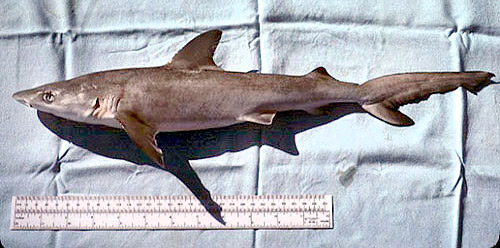
Size, Age, and Growth
The average length of a full-grown blacknose shark is approximately 125 cm (4.1 feet total length), reaching a maximum size of 200 cm (6.5 feet total length) (Compagno, 2005). Depending on geographic location, age of maturity and life span vary. Age of maturity is 4.3 years for males and 4.5 years for females in the US south Atlantic waters. In the Gulf of Mexico, males mature at 5.4 years and females at 6.6 years. For females, longevity in the U.S. south Atlantic is typically 19 years and in the Gulf of Mexico, it is an average of 16.5 years. . A recent study has reported a maximum age of 11.5 years for female blacknose sharks and 9.5 years for male blacknose sharks in the Gulf of Mexico. This shark commonly weighs about 7-11 kg (15.4- 24.2 lbs.) at maturity (Schwartz, 1984). Size at maturity for females 103-118cm (3.38- 3.87 feet) and for males 108-112cm (3.54-3.67 feet) depending on location (Castro, 1983).
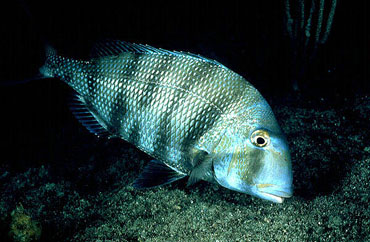
Food Habits
The blacknose shark is a quick swimmer, feeding on small fishes including pinfish, croakers, porgies, anchovies, spiny boxfishes, and porcupine fish. It is also known to feed on octopus (Ford, 2012).
Reproduction
Viviparous with yolk sac placentas (Compagno, 2005). Blacknose sharks mate in late June and early July and have a 10-11 month gestation period. Currently blacknose sharks appear to exhibit two different reproductive cycles in the Northwestern Atlantic and Gulf of Mexico. Studies have shown that female blacknose shark in the Gulf of Mexico reproduce annually, with yolk development (vitellogenesis) occurs concurrently with the late stages of gestation. However, female blacknose sharks in the Atlantic appear to reproduce biennially (once every 2 years) (Ford, 2012).
Litter size for the blacknose shark is 3-6, but the usual number is 4 (Compagno, 2005). At birth, the young measure 17-20″ (43-51 cm) in length. Nurseries for this species are extensive and range from the shallow, coastal waters of Georgia to the shallow waters of central and southern Florida (Castro, 1983).
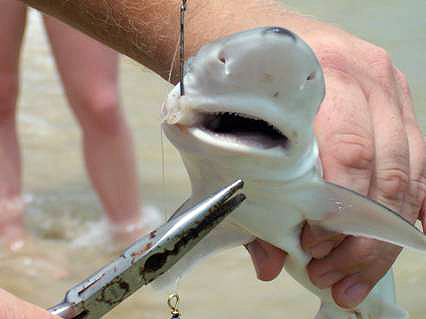
Predators
Larger sharks, including the dusky shark (Carcharhinus obscurus) (Compagno, 2005).
Taxonomy
Squalus acronotus by Cuban naturalist Felipe Poey in 1860. This name was changed to the currently valid name Carcharhinus acronotus by Poey during that same year. The genus name Carcharhinus is derived from the Greek “karcharos” = sharpen and “rhinos” = nose. Synonyms include Carcharias (Prionodon) remotus (Dumeril, 1865) and perhaps Prionodon curcuri (Castelnau, 1855). Representing 25 living species, the Carcharhinidae is one of the largest families of sharks. Sharks in this family are also commonly referred to as “requiem sharks”.
Revised by: Macey Siegel 2020
Prepared by: Cathleen Bester
References:
- Castro, J.I., 1983. The sharks of North American waters (Vol. 1). College Station: Texas A & M University Press.
- Charlier, P., 2001. Review of environmental considerations in management of the Brazil-Guianas shrimp and groundfish fisheries. FAO Fish. Rep., 651, pp.37-57.
- Compagno, L. (2005.). Sharks of the world. London: Collins, p.288.
- Ford, R.M., 2012. Diet and reproductive biology of the blacknose shark (Carcharhinus acronotus) from the Southwestern Atlantic Ocean.
- Schwartz, F.J., 1984. Occurrence, abundance, and biology of the blacknose shark, Carcharhinus acronotus, in North Carolina. Gulf of Mexico Science, 7(1), p.2.
